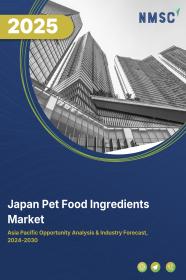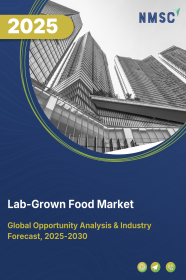
Japan Pet Food Ingredients Market by Type (Non-Vegan, Vegan, and Novel Proteins), by Nature (Organic and Inorganic), by Form (Dry and Wet), by Pet Type (Dog, Cat, and Others), and by Distribution Channel (Online and Offline) – Opportunity Analysis and Industry Forecast, 2024–2030
Industry: Retail and Consumer | Publish Date: 11-Feb-2025 | No of Pages: 117 | No. of Tables: 85 | No. of Figures: 50 | Format: PDF | Report Code : RC2839
US Tariff Impact on Japan Pet Food Ingredients Market
Trump Tariffs Are Reshaping Global Business
Japan Pet Food Ingredients Market Overview
The Japan Pet Food Ingredients Market size was valued at USD 1.53 billion in 2023, and is predicted to reach USD 2.29 billion by 2030, at a CAGR of 5.4% from 2024 to 2030. In terms of volume the market size was 350.41 kilotons in 2023 and is projected to reach 423.24 kilotons in 2030, with a CAGR of 2.3% from 2024 to 2030.
The pet food ingredients market refers to production and distribution of key raw materials required to formulate pet foods that meet the nutritional demands of different species. These ingredients including proteins, carbohydrates, fats, vitamins, and minerals, are sourced from both plant and animal origins and are processed through techniques such as grinding and blending to enhance flavour and nutritional value.
By utilizing high-quality ingredients, it supporting pet health and growth and provide essential nutrients required for pets with specific dietary demands. The companies in this sector focus on obtaining premium ingredients and ensuring transparency throughout their supply chains, improving product quality and meeting consumer confidence. This strategic focus significantly drives market advancement as pet owners increasingly prioritize high-quality food options for their pets.
Rising Pet Ownership Drives the Japan Pet Food Ingredients Market
The growth in pet ownership across Japan is driving the pet food ingredient market forward as urban households increasingly welcome pets, the demand for nutritious and high-quality pet food products rises. This trend is influenced by younger generations and families seeking companionship that led to an increased focus on pet care and nutrition.
As a result, pet food manufacturers are now prioritizing ingredients to meet the changing dietary needs of pets. According to the report published by the German Institute for Japanese Studies, in July 2023 approximately 7 million dogs and nearly 9 million cats resided in Japanese households, indicating that 11.3% of the population owned dogs, while 9.8% owned cats. This surge in pet ownership emphasizes the growing demand for premium nutritional options that contribute to the overall well-being of pets.
Expansion in Disposable Income of Japan Boosts the Growth of the Market
The rising disposable income in Japan propels the development of the pet food ingredient as with improvement in financial conditions of families and individuals, they become more willing to allocate funds toward premium pet food that provides enhanced nutritional content.
This trend towards increased investment stimulates manufacturers to prioritize the sourcing of exceptional ingredients and create innovative products that meet the needs of health-conscious pet owners. According to the World Population Review, disposable income in Japan reached USD 28,872 per household in 2022.
This increasing disposable income enables pet owners to focus on their pets’ health by opting for premium food products. Thus, with growing demand for high-quality pet food, manufacturers are driven to expand their product lines and invest in superior ingredients.
Strict Regulations against Pet Food Ingredients Restraints the Market Growth
The enforcement of strict regulations concerning ingredient sourcing, manufacturing techniques, and labeling standards designed to ensure the safety and quality of pet food products hinders market expansion. These regulations often demand substantial financial resources that diverts the attention from research and development and delay the launch of new products.
Furthermfore, smaller firms find it difficult to navigate complex compliance processes, potentially hindering competition and innovation within the industry. Although these regulations are essential for ensuring product safety, they inadvertently create barriers that limit market growth and reduce the availability of innovative pet food solutions.
Adoption of Sustainable Protein Sources Creates Growth Opportunity for the Market
The transition to sustainable protein sources such as egg-derived proteins, tofu byproducts, black soldier flies, and silkworms is expected to create new opportunities in the pet food ingredient market. These alternatives are increasingly recognized for their rich nutritional content and lower environmental impact when set against traditional proteins including beef and pork.
Egg proteins and tofu derivatives provide nutrients and helps to reduce food waste. Moreover, insect proteins from black soldier flies and silkworms provide an organic and environmentally friendly method of protein production. These sustainable options not only fulfill pets’ dietary requirements but also support the adoption of organic practices, encouraging the industry towards environmentally responsible production and long-term sustainability.
Competitive Landscape
The several market players operating in the Japan pet food ingredients market include Cargill Incorporated, BASF SE, Archer Daniels Midland Company (ADM), Koninklijke DSM N.V., Mowi ASA, Symrise AG, Kemin Industries Inc., FirstMate Pet Foods, Roquette Freres, Ingredion, and others.
Japan Pet Food Ingredients Market Key Segments
By Type
-
Non-Vegan
-
Beef
-
Chicken
-
Fish
-
Others
-
-
Vegan
-
Soyabeans
-
Peas
-
Lentils
-
Others
-
-
Novel Proteins
By Nature
-
Organic
-
Inorganic
By Form
-
Dry
-
Wet
By Pet Type
-
Dog
-
Cat
-
Others
By Distribution Channel
-
Online
-
Offline
Key Players
-
Cargill Incorporated
-
BASF SE
-
Archer Daniels Midland Company (ADM)
-
Koninklijke DSM N.V.
-
Mowi ASA
-
Symrise AG
-
Kemin Industries Inc.
-
FirstMate Pet Foods
-
Roquette Freres
-
Ingredion
REPORT SCOPE AND SEGMENTATION:
|
Parameters |
Details |
|
Market Size in 2023 |
USD 1.53 Billion |
|
Revenue Forecast in 2030 |
USD 2.29 Billion |
|
Growth Rate |
CAGR of 5.4% from 2024 to 2030 |
|
Market Volume in 2023 |
350.41 Kilotons |
|
Volume Forecast in 2030 |
423.24 Kilotons |
|
Growth Rate (Volume) |
CAGR of 2.3% from 2024 to 2030 |
|
Analysis Period |
2023–2030 |
|
Base Year Considered |
2024 |
|
Forecast Period |
2024–2030 |
|
Market Size Estimation |
Billion (USD) |
|
Growth Factors |
|
|
Companies Profiled |
10 |
|
Market Share |
Available for 10 companies |
|
Customization Scope |
Free customization (equivalent up to 80 working hours of analysts) after purchase. Addition or alteration to country, regional, and segment scope. |
|
Pricing and Purchase Options |
Avail customized purchase options to meet your exact research needs. |

















 Speak to Our Analyst
Speak to Our Analyst





















